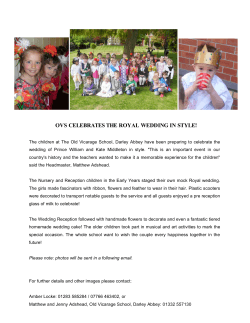
DVB-SH and DVB-T2, why these two new standards?
White Paper N°6 - Sep. 2009 DVB-SH and DVB-T2, why these two new standards? Two new standards, DVB-SH and DVB-T2, have appeared over the past three years causing some confusion with respect to their fields of application. DVB-SH was designed for Mobile TV reception over a large area via a hybrid satellite/terrestrial network while DVB T2 is an evolution of DVB-T dedicated to increase spectral efficiency to carry more data (e.g. HDTV). The objective of this paper is to simulate the performance of each standard for different operational modes and channels and therefore conclude which application is better suited for each standard. DVB-SH The DVB-SH specification was developed during 2006 by an ad-hoc group of the DVB Technical Module and it became an ETSI European Standard in July 2007. The key feature of DVB-SH (Satellite services to Handhelds) is that users in large regions or countries can be reached by just one satellite. Wherever a line of sight between terminal and satellite does not exist, terrestrial gap fillers will be able to provide the missing coverage. The DVB-SH specification has been designed for frequencies below 3 GHz. A typical range in which it will be used is the S Band, which offers more available frequencies compared to the UHF band. High power satellite Interactivity Multicast TV channels Service delivery platform Terrestrial Transmitters DVB-T2 DVB-T2 is a new standard for Terrestrial Broadcasting, approved in June 2008 by the DVB Steering Board. Following a technical study mission and the preparation of commercial requirements, the DVB Project concluded that a new standard should be able to provide increased capacity and ruggedness in the terrestrial transmission environment, primarily (but not exclusively) for HDTV broadcasting to fixed and portable receivers. Terrestrial Transmitters Multicast TV channels Service delivery platform © Copyright DiBcom - MK0909WP6 © Copyright DiBcom - MK0701DP_US 1 DVB-SH and DVB-T2, Comparison Synthesis The following table summarizes the main parameters and technical difference between the two standards. DVB-SH Modulation COFDM: Frequency Carrier S-Band, UHF, L-Band QPSK - 16QAM Frequency Bandwidth 1.7MHz (1k mode), 5MHz to 8MHz Interleavers Channel coding DVB-T2 COFDM: QPSK to 256 QAM UHF, L-band 1.7, 5, 6, 7, and 8MHz (10 MHz for professional application) [BW=5MHz] 4 interleavers (Bit/Cell/Time/Freq) [BW=5MHz] [BW=5MHz] Max interleaving depth:100 ms [8MHz] (72 ms for BBC mode ) • MPE-iFEC (Interleaved FEC) on the Mac layer corrects long duration errors on the MPE section level spanning several consecutive time slice bursts (up to 25s) • Class 1: 320ms in QPSK 160ms in 16QAM • Class 2: 10 seconds Very long interleaver is mandatory for satellite reception (masks effect) Interleaving depth too short for good satellite reception Turbo – Code (+MPE-iFEC) LDPC (~ DVB-S2) +BCH for residual floor errors Code Rate: 1/2, 3/5, 2/3, 3/4, 4/5, 5/6 Code Rate: 1/5, 2/9, 1/4, 2/7, 1/3, 2/5, 1/2, 2/3 Code rates below 1/2 are suitable for tough environments (Mobile TV) The minimum code rate (1/2) is not low enough for Mobile applications. FFT size 1k, 2k, 4k, 8k Guard Interval 1/32 C/N ranges (Gaussian mode) -3 dB (QPSK 1/5) to 7 dB (16 QAM 1/2) -6 dB to 4 dB in Diversity mode Low C/N designed for Mobile TV 1 dB (QPSK) to 22 dB (256 QAM) Patterns 1 pilot pattern (idem DVB-T) 8 pilots patterns : PP1 to PP8 PP1: idem DVB-T (-8% bit rate penalty) PP8: less pilots (-1% bit rate penalty) 1/16 1/8 1k, 2k, 4k, 8k, 16k, 32k 16k and 32k OK for fix applications only 1/4 1/128 1/32 1/16 19/256 1/8 19/128 1/4 Designed mostly for fixed reception at high bit rate (HD) Smaller pilot ratio (as PP8) has been defined to increase capacity. Not applicable for Mobile TV due to poor channel estimation performance. 2 Extended Bandwidth No 7.77 MHz instead of 7.6 MHz at “8MHz” for large FFT only (8k, 16k, 32k) Additional sub carriers together with wider Baseband Filter. Allows more bitrate Physical Layer Pipe (PLP) No A service or group of services that share the same code rate and modulation. Diversity SIMO MISO, SIMO, MIMO (under study) Rotated Constellations No Significant improvement in robustness (5 dB for Code Rate = 5/6), particularly in the case of challenging terrestrial channels (echoes, SFN,…) Future Extension Frame (FEF) No Reserved for either Next Generation Handheld (NGH) standard or future versions of DVB-T2 which might include Full Rate MIMO. Bit rate Max 17.2 Mbit/s (NQAM=4, CR=2/3, GI=1/32, BW=8) 50.6 Mbit /s in 32k mode (NQAM=8, CR=5/6, GI=1/128, PP7, BW=8) Bit rate used For Mobile TV applications: ~5 Mbit/s Ex: BBC1: 35.9 Mbit/s BBC2: 40 Mbit/s DVB-SH and DVB-T2, Simulations and Analysis DiBcom has performed extensive simulations and lab measurements to estimate the performance of DVB-T2 and DVB‑SH for different parameters and under different channel propagation models in order to assess the expected spectral efficiency that can be obtained in the field (for DVB-SH, we have used the lab tests performance found within the framework of the Celtic project B21C). For fixed reception, it is commonly accepted that the Ricean channel (F1) is the best model, whereas for mobile reception, the TU6 Rayleigh model has often been used to compare standards and receivers. The figures below show the spectral efficiency versus the required C/N in mobile environment and fixed reception applications. These figures show that: • In Fig. 1, DVB-SH is better for Mobile TV in the area of very low C/N range, with a very good tolerance to signal loss thanks to the very long interleaver required for satellite reception. The spectral efficiency of DVB-SH clearly shows that it is dedicated for low bitrate mobile receivers and makes it totally not adequate for HDTV signals. • In Fig. 2, DVB-T2 is better for high bit rate when the signal is strong and not distorted by the channel (high C/N). It is highly probable that DVB-T2 will be used at these high bit rates for which a mobile reception is totally impossible. Fig. 1: Capacity Performance in Mobile Environment (TU6 profile) B DV Shannon limit 2 Bit/s/Hz Satellite Demodulation Zone DV H B- 16 -T VB M QA 16 D DV 1 -T2 VB D H VB- SK QP DVB K QPS DV 0 5 10 Shannon limit DVB-SH 2k GI=1/4 DVB-T2 2k GI=1/4 PP1 DVB-H 2k GI=1/4 Mfec=7/8 DVB-T 2k GI=1/4 P HQ B-S 0 K PS -T Q D SK -5 M QA M QA 16 SH B- AM 16Q -T2 15 20 25 (C/N) dB TU6@10Hz The Fig. 1 also shows that DVB-SH performs better than DVB-H in a Mobile environment. The C/N improvement is about 4-5 dB when considering the same spectral efficiency. This result confirms some recent simulations and tests which have shown that a DVB-SH Mobile TV network is about 30 to 40% more cost-effective than a DVB-H one when used in terrestrial mode. Fig. 2: Capacity Performance in Fixed Reception (RICE profile) 256QAM 5/6 6 High Definition Demodulation Zone 5 BBC2 BBC1 Bit/s/Hz 4 3 SH DVB- QPSK 1/5 0 -5 DV T2 0 B-T Shannon limit DVB-SH 8k GI=1/32 DVB-T2 32k GI=1/128 PP7 DVB-T 8k GI=1/32 QPSK 1/2 5 64QAM 7/8 DV 16QAM 2/3 QPSK 1/2 1 256QAM 3/5 France 64QAM 3/4 B- Shannon limit 2 256QAM 2/3 10 15 20 25 (C/N) dB RICE 3 CONCLUSION on Commercial Applications of DVB-SH and DVB-T2 DVB-SH Most decisions in the DVB-SH design were directed by the requirement to maximize Mobile TV satellite Reception and correction of errors due to long interruptions (shading by building, bridge, trees,…). • Two modulation schemes, SHA and SHB are normalized: The SHA mode uses COFDM both on the satellite and terrestrial links and requires satellite transponders to be operated in a linear mode. The SHB mode uses a single carrier / Time Division Multiplex (TDM) on the satellite link but the OFDM signal is maintained on the terrestrial link. This SHB version targets satellite transponders operated in full saturation • Two types of convolutional interleaver have been defined on the SHA physical layer: - Class1 receiver is able to cope with rather short interruptions using a convolutional interleaver with a typical depth of 160ms in 16 QAM and 320 ms in QPSK (for BW=5 MHz). A longer interleaver can be obtained by using MPE-iFEC (Interleaved FEC) on the Mac layer in order to support reception in situations of long duration erasure on the MPE section level spanning several consecutive time slice bursts (up to 25 seconds). - Class2 receiver is able to handle long interruptions but it requires an external memory with a size of 256 Mbit for a correction depth of about 10s. • The Channel Coding in SHA uses a completely new scheme based on Turbo-codes with a minimum value of code rate as low as 1/5 dimensioned for difficult transmission environments. Our lab and field measurements have shown that the commercial requirements have been met by the DVB‑SH standard, offering the highest spectral efficiency at low C/N and strong robustness even in case of long signal interruption. DVB-T2 The DVB-T2 commercial requirements included: • T2 should provide a minimum of 30% capacity increase over DVB-T. [256QAM, less dense pilot patterns, minimum GI ratio = 1/128, extended bandwidth, TFS] • T2 should provide for improved single-frequency-network (SFN) performance compared with DVB-T. [Rotated constellation, long GI in 16k or 32k FFT] • T2 transmissions must be able to use existing domestic receive antenna installations and must be able to re-use existing transmitter infrastructure. [Not possible to use full rate MIMO] • T2 should have a mechanism for providing service-specific robustness; i.e it should be possible to give different levels of robustness to some services compared to others. [Multiple PLPs] • T2 should provide for bandwidth and frequency flexibility. [1.7 MHz to 8MHz, up to 10 MHz for professional usage] Simulations have shown that these commercial requirements have been met by the DVB-T2 standard, offering the highest spectral efficiency at high C/N and without taking into account the problem of signal interruption. Conclusion: While there has been some confusion between the objectives of DVB-T2 and DVB-SH during the development of these standards, this paper clearly shows that each of these standards is dedicated to completely different applications and cannot be used for purposes other than the ones each standard was originally intended for. As the requirements for a next generation handheld (NGH) are constituted, the question remains whether it will be possible to find a way to mix the requirements of both mobile and fixed environments in order to enable a combination of both applications over the same spectrum. As these simulations have shown, the requirements are so different for both applications that it is not an easy task, and DiBcom will be glad to offer its expertise in another future white paper when the time comes! www.dibcom.com DiBcom provides a chip for DVB-SH reception, the DIB29098-SH. It embeds a dual Tuner + two Demodulators offering a MRC diversity reception, improving drastically the performance in term of sensitivity and speed. The DiBcom Octopus platform is based on a programmable Vector Signal Processing engine. It provides a family of powerful flexible and universal mobile TV receiver chip on which the DVB-T2 standard can be supported. H 98-S 290 -a DIB aa-G-TT X B AX Q54.A 4-FF KY 9TT.A 10 - C D3 32 - 10 08 4
© Copyright 2025











